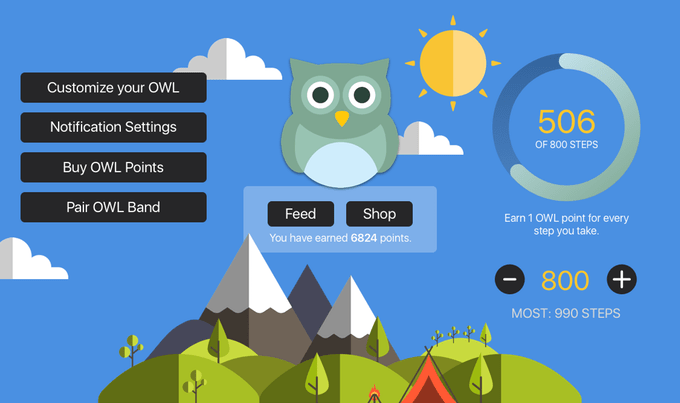
Owl, its creators explains, seeks to address the paucity of kid-focused fitness apps with a unique service — an “experience” in which certain physical activities are rewarded with in-app points. The twist is how those point are spent: kids can feed the app’s eponymous Owl to make it “happier.” The better the bird’s disposition, the more consistent the workout routine.
Owl’s dev team compares the app to the Tamagotchi-style toys of the late ’80s: a virtual pet, of sorts, that must be assiduously fed and nurtured. Only consistent, points-earning exercises will maintain Owl’s “happiness” level — when the exercise routines start to slip, so too will Owl’s temperament.
Gamification may be one way to overcome the insouciance — and resistance, in many cases — to exercise that a large number of kids share. According to the latest stats from the Center for Disease Control and Prevention, almost 23 percent of kids between the ages of 9 and 13 don’t participate in any form physical activity during the week. And a study in the Journal of the American Medical Association found that some spend upward to seven and a half hours a day watching television, playing video games, or using a computer.
Owl offers encouragement in the form of daily notifications. Kids can set daily step goals, too, and track the progress they’ve made on the app’s handy summary screen.
As a supplement to Owl’s digital experience, the team’s produced a nondescript, fitness-tracking wristband. The hardware is respectable — it’s got a built-in OLED touchscreen, charges via USB, and packs a battery that lasts “up to seven days on a full charge.” There is one limitation; Owl won’t be compatible with off-the-shelf fitness trackers from Fitbit or Garmin, at least initially.

Owl’s not the only fitness tracker aimed at younger users, and hardly the first “gamify” physical activity. The UNICEF Kid Power Band wristband lets kids earn points that can be used to deliver food packets through UNICEF to malnourished children; the X-Doria KidFit tracker presents users with a list of points-based daily challenges; the GeoPalz pedometer rewards kids with prizes like skateboards and Frisbees for every step they take; and the LeapFrog LeapBand features a customizable digital pet that, like Owl, “gets happier” with increased steps.
Despite the competition, though, Owl’s in it for the long haul: it launched a Kickstarter campaign with the goal of raising $20,000 by mid-July. Bands start at $30, and backers get a limited edition ceramic disk with a code that unlocks in-app themes and backgrounds. Owl will launch on Apple’s iOS platform first, with Android support to come down the road.
Editors' Recommendations
- I wore the Whoop 4.0 fitness tracker for a month. Here’s why I’m getting rid of it
- The app for your Garmin wearable is getting a huge overhaul
- How an app that tracks your coughs could save your life
- You shouldn’t need an accountant to buy a new fitness tracker
- I ditched my smartwatch for a fitness tracker, and I couldn’t be happier


